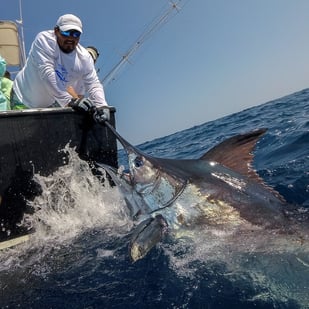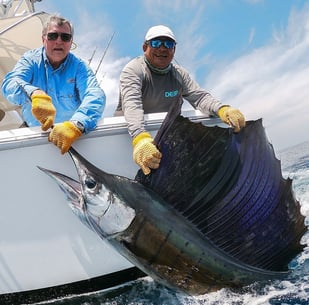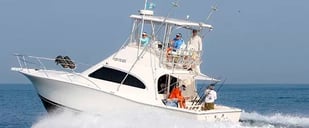Deep Sea, Nearshore Fishing in Quepos
3/4 Day Sport Fishing Quepos CR.
We started Captain Experiences to make it easy to book fishing and hunting guides around the world. With over 1,600 Damn Good Guides, our platform makes finding and booking a trip seamless. Head here to check out our trips.
The Different Species of Marlin
Marlin are some of the most sought after trophy fish for anglers around the world. Their size, strength, and elusive behavior will test the skills, endurance, and mind of any angler. These fish weigh hundreds and sometimes thousands of pounds and are better measured in feet than inches. These behemoth predators require the heaviest of tackle and are often considered the ultimate sportfish.

Blue Marlin
Blue marlin are found in the tropical and subtropical waters of the Atlantic and Pacific Oceans. This fish has a deep royal blue color on top and occasionally have vertical stripes. These massive fish can grow into giants reach 15 feet long and 1,800 pounds. Although the largest marlin in the IGFA record books is a black marlin, the blue marlin is regarded as the largest of the four species. This is because larger blue marlin have been caught but didn’t conform to IGFA rules.
Black Marlin
Black marlin are found in the tropical and subtropical waters of the Pacific and Indian Ocean. This fish has a dark blue-black color above its midline but doesn’t have vertical stripes. Black marlin also feature a dorsal fin that’s exceptionally large. The dorsal fin on a black marlin should be taller than the depth of its body from back to belly. As mentioned earlier, black marlin are one of the largest marlin species and are capable for growing up to 15 feet long 1,800 pounds.
Striped Marlin
Striped marlin are found in the tropical and subtropical waters of the Pacific and Indian Ocean. This marlin species has a silvery belly and deep blue back with vivid stripes along its midline. It also features pectoral fins that do not lay flat like the blue marlin. As one of the smaller marlin species, striped marlin have a maximum size of about 12 feet long and 450 pounds.
White Marlin
Striped marlin are found in the tropical waters of the Atlantic Ocean. These fish are know to only hunt in waters with a surface temperature of 70 degrees or higher. While these fish may look similar to the blue marlin to the untrained eye, they have very distinctive rounded fins. White marlin are the smallest of the four species and top out around nine feet long and 180 pounds.
Marlin Species Overview
Blue marlin are found in both the Atlantic and Pacific Ocean and have a deep blue color and sometimes feature vertical stripes. Black marlin are found in the Pacific Ocean and have a darker black coloration. While black marlin don’t have stripes the do grow to a similar maximum size of blue marlin of around 15 feet long and over 1,500 pounds.
Striped marlin are also found in the Pacific Ocean and features prominent stripes on its side along with an exceptionally tall dorsal fin. These fish are also typically much smaller than blue marlin, topping out around 12 feet long and 450 pounds. White marlin on the other hand are found in the Atlantic ocean and have rounded fins. These are also the smallest of the Marlin species and only reach a maximum size of around nine feet long and 200 pounds.
These predatory fish are typically found miles offshore near the 100 fathom curve, continental shelf, or Gulf Stream Current. The extended distances and deeper water that comes with targeting these fish requires specialized techniques to catch them. Here are the most common approaches used to target marlin.
Trolling For Marlin
Marlin are typically caught by trolling, plugs, spoons, and various baitfish in deep offshore waters. Plugs have large, solid heads generally made of plastic with a line pass-through drilled through the middle. The back of the plug has a skirt made of colored soft plastic and reflective strands, making iit resemble a squid or baitfish while also concealing the hook.
Trolling bait like ballyhoo or needlefish requires a wire leader with two hooks spaced six to ten inches apart. The first hook goes through the head pointed down. and the second hook is pushed completely through the middle of the bait then hooked point up through the fish near the anal fin before being twisted point down and secured back into the body. This setup allows the bait to have a natural appearance and swimming action.
Joey Butrus
Updated on July 31, 2023

November 15, 2023

January 19, 2021

April 26, 2022

January 7, 2022

October 26, 2020
Related Articles
July 18, 2022
June 13, 2022
March 8, 2021
Featured Locations
- Fishing Charters Near Me
- Austin Fishing Guides
- Biloxi Fishing Charters
- Bradenton Fishing Charters
- Cabo San Lucas Fishing Charters
- Cancun Fishing Charters
- Cape Coral Fishing Charters
- Charleston Fishing Charters
- Clearwater Fishing Charters
- Corpus Christi Fishing Charters
- Dauphin Island Fishing Charters
- Daytona Beach Fishing Charters
- Destin Fishing Charters
- Fort Lauderdale Fishing Charters
- Fort Myers Fishing Charters
- Fort Walton Beach Fishing Charters
- Galveston Fishing Charters
- Gulf Shores Fishing Charters
- Hatteras Fishing Charters
- Hilton Head Fishing Charters
- Islamorada Fishing Charters
- Jacksonville Fishing Charters
- Jupiter Fishing Charters
- Key Largo Fishing Charters
- Key West Fishing Charters
- Kona Fishing Charters
- Madeira Beach Fishing Charters
- Marathon Fishing Charters
- Marco Island Fishing Charters
- Miami Fishing Charters
- Montauk Fishing Charters
- Morehead City Fishing Charters
- Naples Fishing Charters
- New Orleans Fishing Charters
- New Smyrna Beach Fishing Charters
- Orange Beach Fishing Charters
- Panama City Beach Fishing Charters
- Pensacola Fishing Charters
- Pompano Beach Fishing Charters
- Port Aransas Fishing Charters
- Rockport Fishing Charters
- San Diego Fishing Charters
- San Juan Fishing Charters
- Sarasota Fishing Charters
- South Padre Island Fishing Charters
- St. Petersburg Fishing Charters
- Tampa Fishing Charters
- Tarpon Springs Fishing Charters
- Venice Fishing Charters
- Virginia Beach Fishing Charters




























